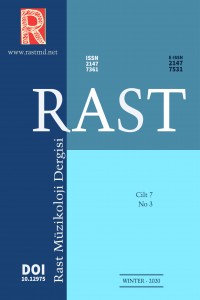Öz
Kaynakça
- Bartok, B. (1991). Küçük Asya’dan Türk Halk Musikisi. (B. Aksoy, Çev.) İstanbul: Pan Yayıncılık.
- Duygulu, M. (1995). Gaziantep Türküleri. İstanbul: Sistem Ofset.
- Hoşsu, M. (1997). Geleneksel Türk Halk Müziği Nazariyatı. İzmir: Peker Ambalaj.
- Özbek, M. (1998). Türk Halk Müziği El Kitabı 1. Terimler Sözlüğü. Ankara: Atatürk Kültür Merkezi Yayınları.
- Sarısözen, M. (1962). Türk Halk Musikisi Usulleri. Ankara: Posta Matbaası.
- Soysal, F. (2012). Rast Muğamı Çerçevesinde Azerbaycan Muğam Kavramı. Diyarbakır: Fikri Soysal Yayınları.
- Şenel, S. (1992). Türk Halk Musikisinde “Uzun Hava” Tanımları ve Bu Tanımlar Etrafında Ortaya Çıkan Problemler. IV. Milletlerarası Türk Halk Kültürü Kongresi Bildirileri. III, s. 287-309. Ankara: Ofset Repromat Matbaası.
- Yurtçu, C. (1996). Tokat Çevresindeki Ezgilere Yapılan Açışların İncelenmesi. (Basılmamış Yüksek Lisans Tezi). İstanbul: İstanbul Teknik Üniversites iSosyal Bilimler Enstitüsü.
- Yürümez, E. (2019). Uzun Hava Türleri (Araştırma-İnceleme, Notasyon ve Metodolojik Eğitim). Basılmamış Yüksek Lisans Tezi. Elazığ: Fırat Üniversitesi Sosyal Bilimler Enstitüsü.
Öz
In Turkish music, while the view regarding the non-inclusion of nonmetric musical structures in notation has been prevalent until recently, it can be accepted that some progress has been made in this regard nowadays. However, it cannot be said that the existing notation methods can meet the needs even today. We believe that the most important reason for this is that the emerging note cannot adequately reflect the performance of the resource person. The lack of the metronome of the note and the failure to develop a strategy for determining the unit time value can be shown as the main points that make us think that the current notation is not enough to reflect the performance. Gazel in Turkish classical music, qasida in religious music, and uzun hava in Turkish folk music and accordingly improvisation or taqsim in folk music are nonmetric musical structures. In this paper, an example of the applications performed to improve the notation of nonmetric structures was presented to those concerned. As a performance of notation, the work entitled Sarı Yazma, which was randomly performed by Çekiç Ali, was selected with nonmetric folk song samples in folk music. These applications were made using the Sibelius 6 software. Furthermore, the current notation of the same nonmetric folk song made by another researcher will be compared with the notation made by us.
Anahtar Kelimeler
uzun hava in Turkish folk music gazel qasida nonmetric melodies notation
Kaynakça
- Bartok, B. (1991). Küçük Asya’dan Türk Halk Musikisi. (B. Aksoy, Çev.) İstanbul: Pan Yayıncılık.
- Duygulu, M. (1995). Gaziantep Türküleri. İstanbul: Sistem Ofset.
- Hoşsu, M. (1997). Geleneksel Türk Halk Müziği Nazariyatı. İzmir: Peker Ambalaj.
- Özbek, M. (1998). Türk Halk Müziği El Kitabı 1. Terimler Sözlüğü. Ankara: Atatürk Kültür Merkezi Yayınları.
- Sarısözen, M. (1962). Türk Halk Musikisi Usulleri. Ankara: Posta Matbaası.
- Soysal, F. (2012). Rast Muğamı Çerçevesinde Azerbaycan Muğam Kavramı. Diyarbakır: Fikri Soysal Yayınları.
- Şenel, S. (1992). Türk Halk Musikisinde “Uzun Hava” Tanımları ve Bu Tanımlar Etrafında Ortaya Çıkan Problemler. IV. Milletlerarası Türk Halk Kültürü Kongresi Bildirileri. III, s. 287-309. Ankara: Ofset Repromat Matbaası.
- Yurtçu, C. (1996). Tokat Çevresindeki Ezgilere Yapılan Açışların İncelenmesi. (Basılmamış Yüksek Lisans Tezi). İstanbul: İstanbul Teknik Üniversites iSosyal Bilimler Enstitüsü.
- Yürümez, E. (2019). Uzun Hava Türleri (Araştırma-İnceleme, Notasyon ve Metodolojik Eğitim). Basılmamış Yüksek Lisans Tezi. Elazığ: Fırat Üniversitesi Sosyal Bilimler Enstitüsü.
Ayrıntılar
| Birincil Dil | İngilizce |
|---|---|
| Bölüm | Orijinal araştırma |
| Yazarlar | |
| Yayımlanma Tarihi | 2 Şubat 2020 |
| Yayımlandığı Sayı | Yıl 2019 Cilt: 7 Sayı: 3 |
Yazarlarımızın editöryal süreçlerin aksamaması için editöryal emaillere 3 gün içinde yanıt vermeleri gerekmektedir.


